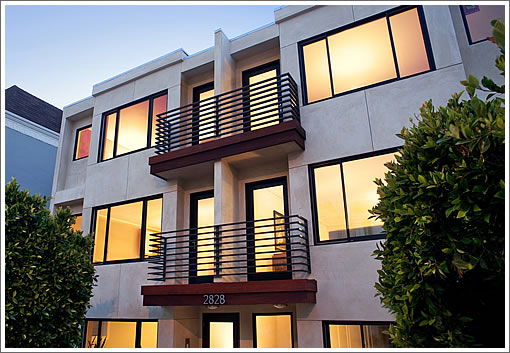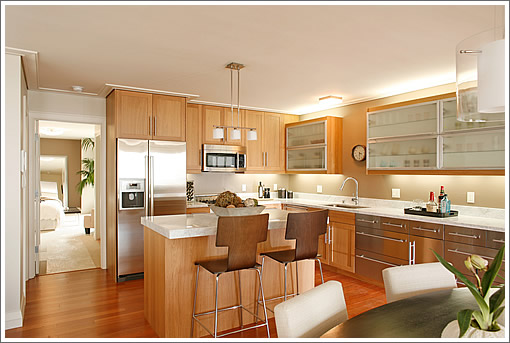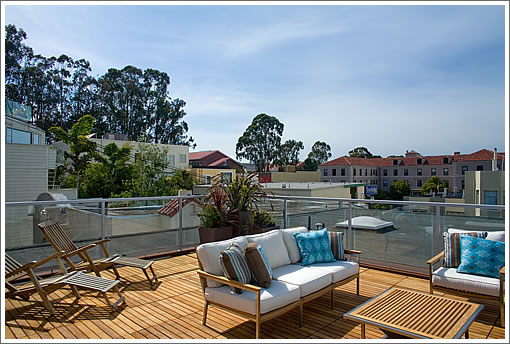
Readers keep asking, and we finally have all (okay, so more like most) of the answers with regard to 2828 Greenwich Street. Eight TIC units (six two-bedroom/one-bath, two three-bedroom/two-bath); built in 1960, extensively renovated in 2008, no evictions, individual financing; and one car parking per unit.

Individual solar-generated electrical systems (2-kilowatt on average) with reverse meters for account credit when use is less than what’s gathered, “solar hot water panels to supplement the building’s gas fired hot water heater,” and a common 400+ square foot roof deck with glass railings (for individual solar bathing).

Pricing isn’t yet set in stone, but the two-bedrooms are expected to start around $800,000 with the three-bedrooms around $1,200,000; first official showings either this Sunday or next Thursday; and floor plans with square footage for all units are available online.
∙ 2828 Greenwich Street [2828greenwich.com]

Maybe I’m missing something, but their 2/2 (unit 3) is really a 2/1. Also unit 1’s front door leads directly into a bathroom…
Someone should tell the web designers accross town that the marble is CarrAra, not CarrEra. Not that anyone is expected to pick Carrara on a map of Italy, it’s such a small and non-descript italian city.
Looks like Ikea cabinets as well as low ceilings w/fixures…i.e. no recessed lighting. They could do better for >$800/ft.
Killer location though…….
Even with individual financing, isn’t it terribly risky to buy into a TIC with this many units?
@curious: what would be the terrible risks and how are they greater than in a condo complex? The only thing I can come up with would be the bank not offering the loans anymore or some drastic law that makes TICs (of all unit composition and number) highly undesirable. Personally, I don’t see either one happening.
@also curious:
With 8 units, there is a higher chance one unit will go into foreclosure/bankruptcy, which means the rest of the units have pick up the property tax and HOA slack in the interim. Each unit probably has +-12.5% of the bill, so it’d be an extra 1.79% for each unit if one unit stopped paying.
You also have the fun part of trying to get a majority of people to do something when building maintenance is required.
People.. fractionalized TIC buildings are for all intents and purposes no different than a condo complex with an HOA. Same structure, separately deeded and financed units, and group decisions are made just as in a 3 unit condo HOA or a 300 unit high rise condo HOA. And fractionalized TIC is the proper structure for an 8 unit building because they are not allowed to convert to condo under current law.
Thanks Ryan and dg,
I see that in a TIC HOA with individual loans, the main difference from a condo HOA is that the property tax bill and maintenance is still shared. If a unit were to foreclose and that unit’s reserves were depleted prior to being able to sell, I would be on the hook for 1.79 percent of those responsibilities. Assuming 1200/month for HOA and taxes for the foreclosed unit, that would be $171 per month extra per non-foreclosed unit until the place could be sold. This doesn’t seem *too* risky to me. Especially since I think you could extract that money as part of the sale or from the bank. That, combined with the more rigorous lending standards for TICs make this seem like a pretty solid venture. It actually seems like this is less risky than a 3-unit condo where there would only be 2 other parties to pick up the tab.
As for making decisions in a group, well, that is always an issue. Again, it would seem easier to overrule the one wacko on the group when you have more voices at the table. It would also seem that being a larger group would provide some economies of scale, making it more practical to hire an accountant, a landscaper, etc., so the place could be professionally maintained on a schedule with less involvement from the HOA members (i.e., like a larger condo HOA).
The quality of the remodel *looks* pretty good and the location is fantastic. I look forward to checking it out in person.
Property tax bill for individual TICs is shared – correct, but maybe not for long. Plan C (www.plancsf.org) and the TIC Coalition have been working with the Assessor’s office to get them to switch to an individual TIC tax bill structure. Assessor isn’t there yet, but within the next few weeks the office will make an announcement about a move in that direction.
What a great location! I would think that they wouldn’t have any problems with owners defaulting at these prices and at this time when lenders have tightened restrictions. I’ve seen this building before the renovation. Looks SO much better now. Nice job!
I forgot another aspect of mega-TIC ownership:
Since you still own an undivided interest in the entire building, a death intestate (without a will) or with a contested will can put the *entire* building into probate for several years, which could (but doesn’t have to) encumber a sale by any other TIC owner while the dispute is resolved.
This can happen no matter what the size of the TIC, but again, more people just increases the chances. This does not happen with a condo because you hold title to your unit, instead of the entire building in common.
I’m interested in hearing more about the possible risks of TIC’s. Does the editor have a link to previous discussions on this topic? I know it’s an evolving issue and lenders, and now it sounds like possibly the assesor, are making changes to reduce risk but why are TICs sold at considerably lower cost/sf than condos? Is it just a perceived risk due to lack of understanding the details? Anyone have any info for other sources on this issue? Thanks.
When it comes to decision making about maintenance, the key is to have an odd number of condo OR TIC owners in order to avoid tie votes. I have a friend in a two-unit condo who struggled with his partner over whether to replace the roof (as the owner of the upstairs unit, my friend wanted it far more than his downstairs partner). Had there been a tie-breaking vote the decision would have been easier.
Typically the reason TICs are ‘discounted’ is the risk spread with the combined loan.
That and in this case you need to get 8 people together to agree on loan terms, with similar downpayments etc, I would imagine it might be harder to get a loan of this size / scope in the current climate.
I’m in a 2 unit TIC, and we’re in the process of going Condo, which entailed a lot of money to bring the building up to code, and also a chunk of money to the city to convert. About 9K in fees to the city for a 2 Unit Conversion.
4K to Map the property.
1500 to Lawyers, which I would strongly advise doing, to help prepare your condo package.
So for us, it was a matter of being in the property for 1 year, then you can ask the city for inspections. ($500). They inspect it and tell you what you need to fix to be condo ready. Some simple stuff, hand rails, electrical outlets outside, water outside etc etc.
In a 3 or more unit building you go into the condo lottery, which is why there’s a steeper discount on TIC units with more than 2. For a 2 unit to convert it’s simply a time/money deal.
For a 3-6 Unit it’s the Lottery, and as I confirm that I note that you can only condo convert up to 6.
So in this case, I have no idea how you go Condo in an 8 Unit
@ryan,
with individual or fractional financing you do not have the worry of someone in the building not paying-the bank that made the loan does. tic’s are set up with a six month funded reserve for this specific issue and that rule is mandated by the DRE.
the DRE also mandates that a bank who gets in the tic loan game has to stay in it and that all financing has the option of 30year amortization.
a properly crafted tic agreement can also deal with the death intestate issue so that the whole building is not forced into probate.
despite your assertions as to what can go wrong i believe that some smart people have worked out the risks to buyers (with strict oversight from the DRE) and the protections for the consumer are robust.
Looks like the person living in bedroom #2 has to go into Bedroom #1 to shower, etc?? Major drawback?
Paco – Does the capital for the 6 month “bankruptcy reserve” come from the TIC buyer’s down payments ? If so then it seems as if the surviving owners are still on the hook to cover a bankrupt partner. The only difference is that they paid in advance.
And once the reserve empties, I would guess that the hat gets passed around to the remaining owners.
With respect to the characteristics of TICs, as people have mentioned, you will not be able to convert this building into condo’s because it has more than 6 units.
Another important thing to note (and someone please correct me if I’m wrong here) is that you will generally not be able to borrow against your equity in the place – banks don’t just carry these loans, they typically make TIC loans out of their own capital bases. So refing is typically out, and your capital is locked into the unit with little option other than to sell should you want to get your money out. fwiw…
great site for TIC by the leading TIC attorneys in the city.
http://www.g3mh.com/articles.htm
That for me is the interesting thing about this TIC.
It can’t ever be a Condo, unless the laws change, so I don’t see the benefit of this over something else.
I saw the benefit in buying into a TIC, and going Condo, as it increases the value, but this looks almost more like it is a co-op
@MoD,
actually the six month reserve is initially funded by the developer who is then paid back as each unit is sold. therefore the reserve is always (by law) funded. when somebody stops paying their mortgage or dues then the tic board will spring into action using the remedies spelled out in the tic agreement-which include initiating a foreclosure on the unit. as the bank holds the risk they can be counted on to defend their capital by selling that interest on the open market. that’s typically why tic loans require at least 10% down payment, and often more.
bottom line is its the banks problem more than the other co-owners.
@tetTrees,
you are right that pulling equity out is not possible and as someone mentioned, a tic is closer to a co-op than a condo.
Paco, always enjoy your posts as they reflect real experiences from “in the trenches”.
My one comment on TICs would be that a partition sale is the “sword of Damocles” that hangs over a TIC, and you wouldn’t have that in a condo. My understanding, from a previous poster on another thread, is that the “sword” passes to the bank in a “fractionalized loan” situation. I should highlight, its doubtful that the bank would ever go that route as the unit will most likely be worth more than selling the building as a whole. Nevertheless, it is a differentiator.
Finally, investors must realize that each owner in a TIC can force a sale of the property by filing a partition action. A partition action is essentially a complaint to a court stating that the owners cannot agree on how to manage the property and that the property should be either split into parts (which is not possible for most improved properties) or sold. Waiving the right to partition in the TIC agreement, however, may cause the IRS to treat the TIC as a partnership for tax purposes. One solution that most TIC agreements utilize is to give the other owners a right of first refusal to purchase the interest of an owner before he or she can file a partition action.
Hmmm… I just noticed this: solar hot water panels to supplement the building’s gas fired hot water heater. Notice the singular form the noun water heater. So I guess the water main is common to all units… chalk up one in the “shared liability” column during these times of water rationing (well at least in the East Bay for now…)
EBGuy’s point illustrates how TICs can indeed be a good deal but one must be extremely careful in the selection of TIC partners. You don’t want to dive into this with 7 strangers. Indeed, all these risks are the reason TICs are priced lower than condos in the first place. It is absurd that SF does not permit these places to turn condo (at the very least, it would up the transfer fees and property taxes going forward as the units would be more valuable).
Does anyone recognize the outdoor furniture? I’m in the market and I like the look of it very much. Thanks.
Was this building rentals previously? Was there a tenant buyout?
So, is there no disincentive to Ellis the hell out of a 6+ unit building in SF since you can’t condo convert anyway?
there is less and less disincentive to ellis your property. in fact misguided rent control policies are to blame for creating unintended consequences.
What’s the deal with some of those layouts? How does one get to the bedrooms on the left in Layout 1 and 2? It also looks like there’s 4 bedrooms in those units.
The location is great.
Those bedrooms on the left are in other units (unit 3 on unit 1’s layout, unit 4 on 2’s layout). It is strange that they put those on the diagrams. It also looks like one bedroom each on unit 1 and 2 is actually a living room.
From EBGuy: “So I guess the water main is common to all units… chalk up one in the “shared liability” column during these times of water rationing (well at least in the East Bay for now…)”
So how is that different from a condo? Nearly all multi-family buildings have shared infrastructure. ORH, for example, you have the “shared liabilty” of the elevators as well as water, common area lighting, etc. I don’t see anything unusual about this TIC having a shared, commercial-grade water heater. Hell, that things is certainly more efficient and reliable than the typical water heater in a single-family home.
My point was that you’ve got to worry about the owner in Unit 2, who takes long showers, and is driving up the monthly HOA assessements 🙂
Anyone else in a condo want to comment if their water is metered separately? Okay, it was stretch…
Hell, that things is certainly more efficient and reliable than the typical water heater in a single-family home.
For the eco-focus of the building, I was hoping for individual tankless heaters — one can dream…
It seems to me that the most intelligent way to employ a common solar heater in a shared building is to use it as a pre-heater. Each unit would still have its own gas or electric heater, but the input water would be warmer and hence the small in-unit heater would consume less energy.
There’s still a problem with water volume metering. I guess you could get around that by having two meters for each unit : one for cold and one for solar heated warm water.